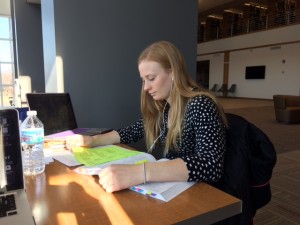Campus Culture Story: Final Draft
8 12 2014It’s approaching 9 p.m. Sunday night in the Hickman Johnson Furrow Learning Center. Usually, at this point in the weekend, students have retired to their rooms to finish off the night with some of the Walking Dead or maybe a couple games of Madden, but today is different.
Three-fourths of the library tables are occupied and completely covered in study materials: chemistry books, philosophy notes, nursing study guides, and cups of coffee from the Spoonholder. Students seem to be on edge, brows furrowed as they type out that concluding paragraph to the senior thesis that is the culmination of their college career. Others look as if they’re moving closer to the “screw it” stage; heads on the desks and a blank Microsoft Word document open on their computers.
From the very atmosphere, it quickly becomes obvious that it is finals week at Morningside College. During the last week of the semester, students can be found across every college campus in the country consuming inordinate amounts of caffeine, pulling all-nighters to study, completing ten page papers in one marathon session, and sometimes even breaking down crying.
However, here at Morningside, a student’s finals week experience can vary greatly depending on his major, class load, and grade level. Some students end up using the fall semester finals week as a break from class, a time to watch movies and hang out with their friends, while others have to dedicate the entire time to work and study.
Some of the most stressed students end up being freshmen who are going through it all for the first time.
“I had a panic attack yesterday,” said freshman Jen Bentz after the end of Thanksgiving break. “We didn’t really have finals at my high school, so this is all really intense.”
As a music education major, Bentz will have five different finals, two of which are based on music performance.
Other students have it much easier. Junior computer science major Michael Andrlik just has one test during finals week.
“Pretty much, my finals week consists of procrastination and eventual work,” said Andrlik.
For Andrlik, and many other students in project and writing-based majors, the week before finals week is actually the most challenging week. His finals week is a bit of a break after an arduous penultimate week filled with deadlines and presentations.
“During actual finals week, if it’s getting close to my test, I’ll be actually doing stuff, but for the rest of the week, I’ll be playing video games,” he said.
Many professors in writing-based majors find that it is difficult to assign a true final because grades are due so soon after finals.
“There’s a short turnaround between finals week and the day grades are due,” said associate professor of mass communications Ross Fuglsang, “So, it’s difficult to assign essay tests and get them graded by the deadline.”
Other students, especially those in subjects that lend themselves to easy-to-grade multiple choice tests, find that the last two weeks of the semester feel like an extended finals week, a jam-packed marathon of studying and writing.
“For me, both weeks are pretty hard,” said sophomore biology and chemistry teaching major Evelyn Edge. “I have a bunch of papers and presentations this week [the week before finals] and then next week I have finals in every class but art. I spend finals week in my own little hovel in the library. “
Many students across campus wish that Morningside would imitate other colleges in implementing a “dead week” policy. Some larger universities (and even smaller ones like Dordt) enforce policies where professors can’t have major deadlines or tests during the week before finals. The idea is that students will have an extra week or so to prepare for finals.
“All of my high school friends are at bigger schools or community colleges, and they have a dead week,” said Bentz.
Senior nursing majors Jaimie Fast and Anna Christensen both have tests in the week before finals.
“Even if Morningside would just give us half a week off, that would help, because it would stop teachers from giving us tests right before our finals,” said Fast. “When it gets to finals week, you pretty much just have to cram because we’re too busy studying for our other tests to prepare in advance.”
Where some students like Andrlik use finals week to unwind from a busy semester, Christensen tries to use every second of her week to prepare.
“Here’s how my days go: Wake up as early as you can, study a little, eat breakfast, drink an energy drink, cram, take a test, cry, drink a beer, take a deep breath, and start to study for the next one,” she said.
Categories : Feature Writing

